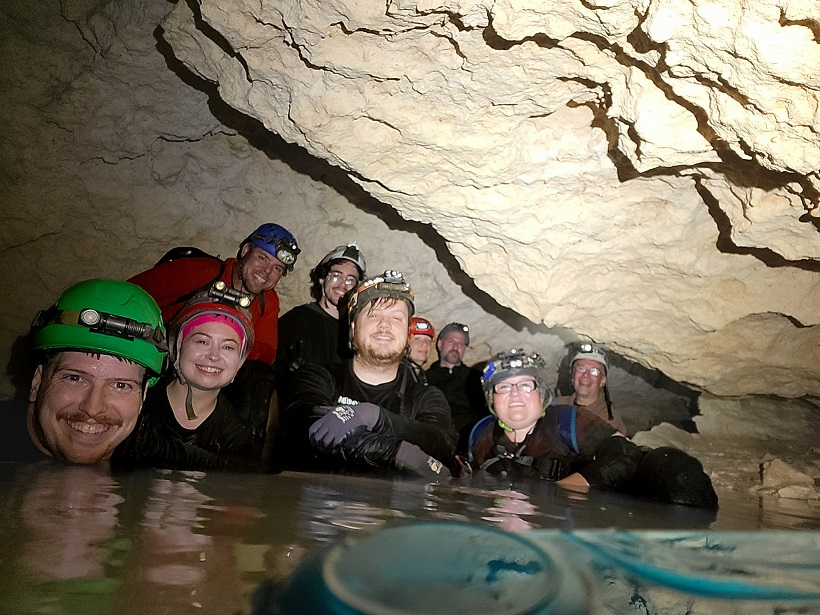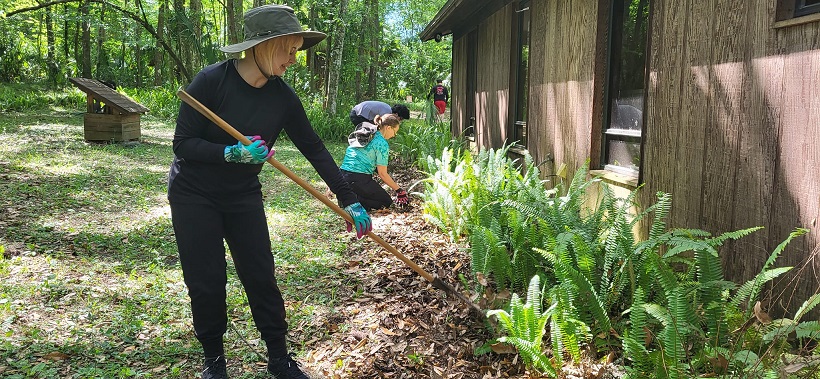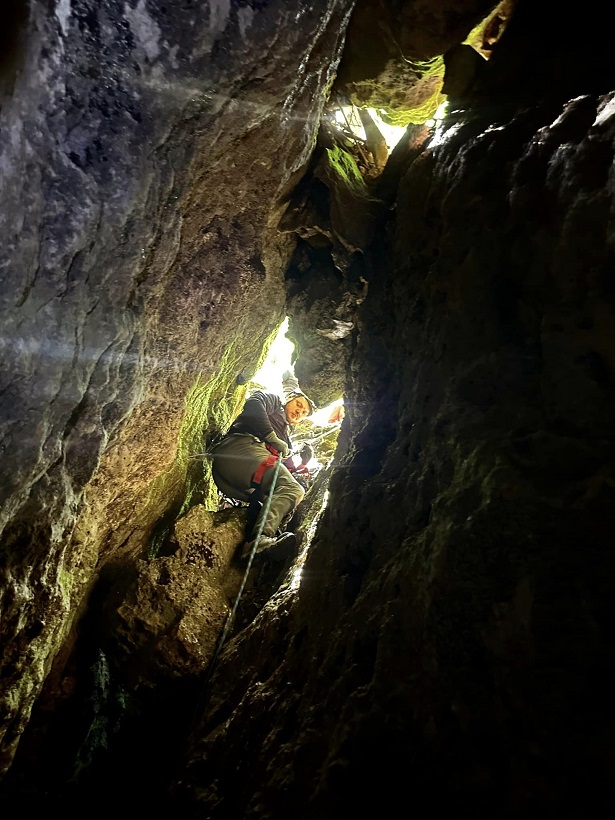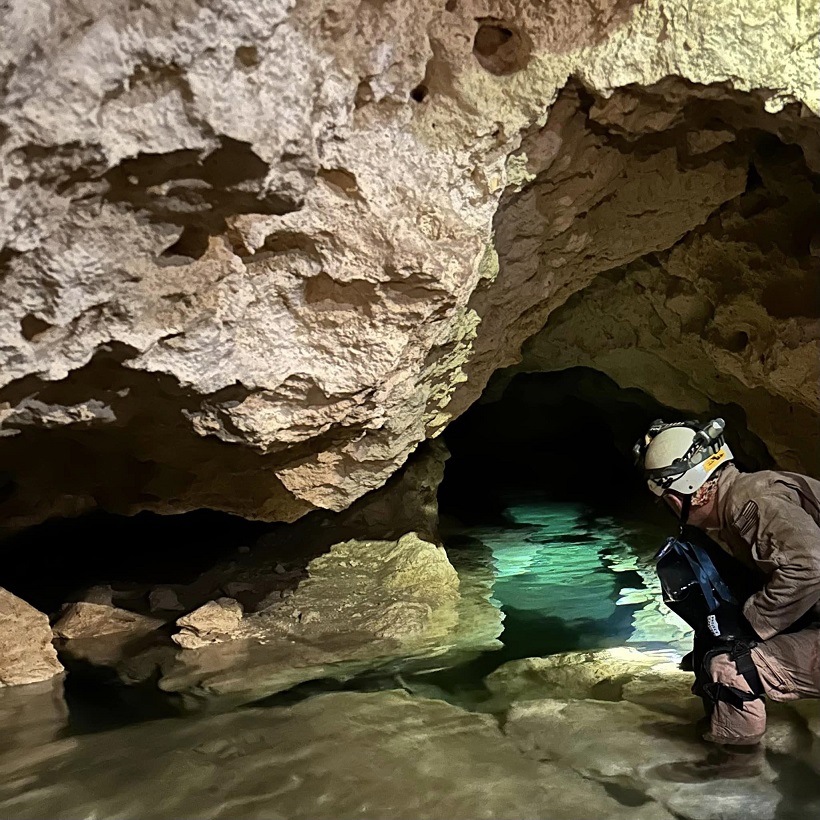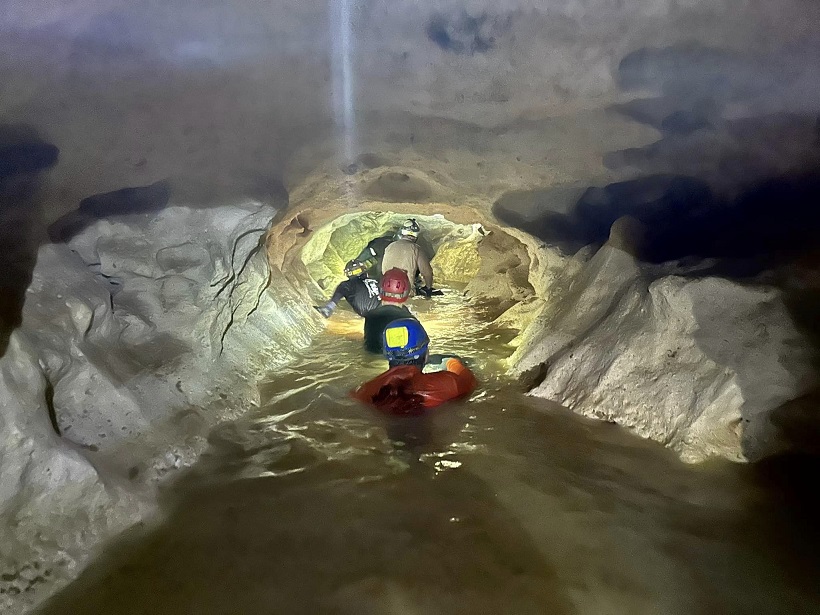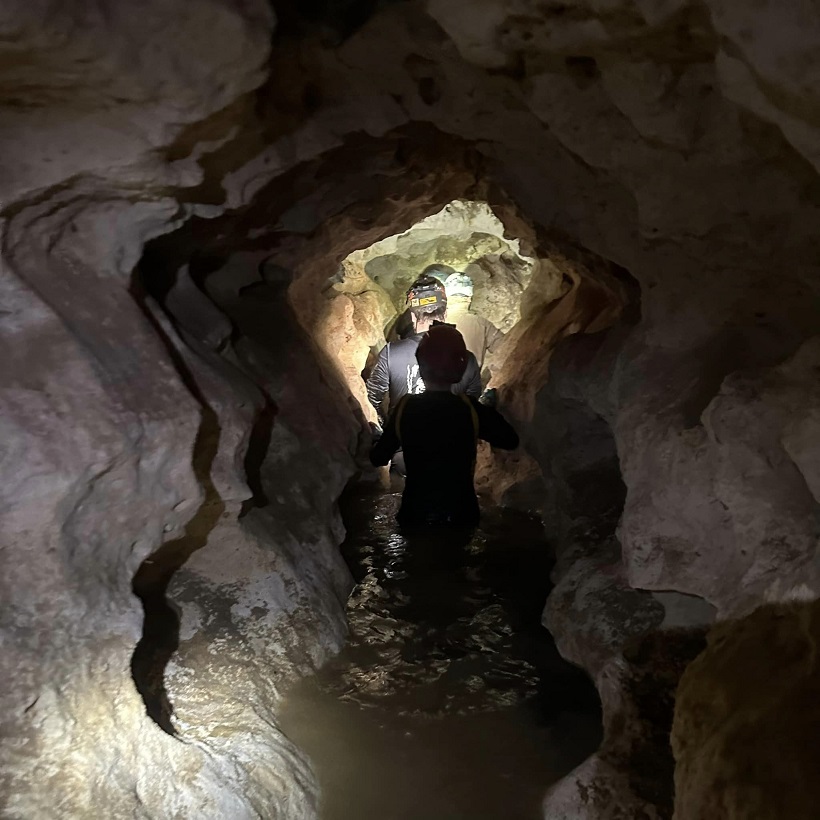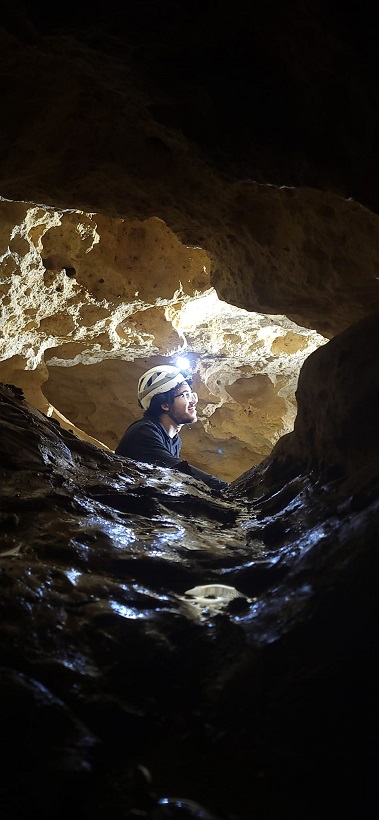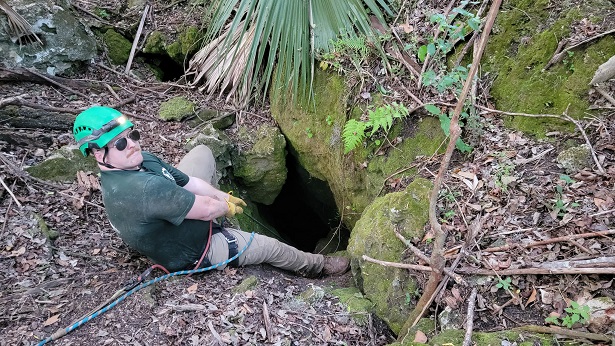By The Sleezeweazel, first published in The Florida Speleologist September 2023 Issue
Know my children that Ecuador, like all Andean nations, is a place of extremes. There, tectonic cataclysms have created the world’s greatest mountain range. Don’t believe that hype about Everest being the tallest, for the peak of Volcan Chimborazo is the farthest place on earth from the center of the earth. I once peered directly into the caldera from the safety of a jetliner and concluded that Hell hath no fury like the snow swept rim of a stratovolcano.
Any place with that many volcanoes is certain to have lava tubes, and there may well be isolated outcrops of limestone, but throughout the Andes such formations are often covered with volcanic deposits. Aside from that, whatever caves may exist in the high Andes are certain to be cold, and the Weazel doesn’t do cold!
To the west of the Andes lies the arid Pacific coast and the wretched city of Guayaquil, home of pickpockets, prostitutes, and drug cartels. When you read about the crime wave sweeping Ecuador that news pertains to the west coast, and especially the swarthy area adjacent to Colombia. I’ve never been to the west coast of Ecuador and have no interest in going.
To find caves in Ecuador one must travel to the Amazonian pre-cordillera. Once upon a time, long before the rise of the Andes, what is now the western part of the Amazonian rainforest featured a shallow sea favorable to the deposition of limestone. As the Andes rose these ancient deposits were crumpled, rumpled, folded, sliced, and diced into the complex terrain that is now known as the pre-cordillera, a land of steep slopes and soggy impenetrable cloud forest.
So it was that the Weazel journeyed to the funky little jungle town of Misahualli at the very foot of the mountains. It is here that the Rio Napo, mightiest tributary to the Amazon, first becomes navigable.
Misahualli is at the foot of the Andes.
I had fond memories of the place for I had been here 24 years earlier when the tiny town was truly the end of the road and the jungle beyond beckoned. Allow me to digress to describe the strange scene I once witnessed there.
One day in 1999 I sat down at a corner bar by the Misahualli central plaza and ordered a beer. I was amazed to observe that the plaza was dominated by Capuchin (think organ grinder) monkeys. Each corner of the plaza had a boss monkey and his entourage. That was odd enough, for unlike in southeast Asia where monkeys are often tolerated in cities, in South America monkeys are considered to be pests at best. Stranger still was the fact that the plaza was full of fancy thoroughbred dogs, not the mangy mongrels that plague every third world village. The monkeys appeared to be in control of the dogs. This was not the first time I had ever seen a dog take orders from a pet monkey, but these were wild monkeys!
The monkeys were busy squabbling among themselves when suddenly the big boss monkey shouted “Look! Down by the beach! Here he comes!” (In monkey talk of course). All the other monkeys turned to look. Up from the canoe landing came a much larger Spider monkey walking on his hind legs and looking like a swaggering cowboy on his way to a gunfight. The other monkeys were terrified! (Spider monkeys are big, mean, and stupid; whereas, Capuchin monkeys are small and smart.)
Monkey beach on the Rio Napo, Misahualli.
What to do about the bully? Each plaza monkey had a small pack of dog friends which they called to their sides, then the big boss monkey summoned an enormous great Dane to lead the assembled dog army against the Spider monkey. The great Dane really was great, a natural leader who kept good order among the other dogs. He led the army up to the Spider monkey and let out one low growl. That did the trick! The bad monkey fled to the great amusement of the people in the plaza. What’s not to love about a jungle town controlled by wild monkeys who command an army of well behaved dogs?
Fast forward to this summer. The little town of Misahualli, henceforth known as Monkeytown, hadn’t changed much, but there were now roads leading into the surrounding jungle. Settlers had flooded in from the overcrowded highlands, and fancy eco-tourism lodges had sprouted like poisonous mushrooms.
Where beer costs extra!
The Weazel has a special hatred for the “eco-tourism cartel” that sets the price and agenda for all such jungle eco-lodges. Leftist do-gooders have convinced the Indians that since a lawyer in New York City makes $300/hour then it is only fair for an Indian to charge the same amount to lead some gawking tourist through the jungle, and then to charge the same amount for the poor sucker to have an “authentic” experience by spending the night in a thatched hut that would normally rent for the inflated price of $10. As for myself, I stayed in a $12 flop house.
I was dismayed to see that the monkeys had been driven from the plaza to the periphery of town, but a monument had been erected in their honor.
Dems look like Go-rillas to me!
The monkeys must have learned how to read, for they, along with countless eco-tourists, now congregate near a colorful sign down by the river, there to solicit food, then bite the hand that feeds them.
My what big teeth you have! Image swiped from the web.
One could not ask for a more authentic experience than to be bitten by a monkey, and it’s free!
There is big money to be made treating bite wounds!
Wherever there are tame monkeys there are sure to be tame Indians. This lovely lady chased me around town while brandishing her weapons, but I declined to take a photo until I caught her on her way home.
OK, I surrender!
When I first visited Monkeytown the surrounding jungle was unbroken wilderness; but all good things must pass, so now there are new roads and settlements spreading across the disappearing jungle like varicose veins.

Do not be fooled by the overly ambitious map. The roads shown here barely exist, and the “tourist attractions” such as the balnearios (swimming holes) and caves, are more aspirational than actual. If a poor peasant discovers a cave while hacking down the jungle he dreams big and announces it to the world, or to whoever will listen. The government wants to encourage ecotourism, so even a rumor gets put on the map. That was how I discovered the Caverna Lluya Jugado seen at the top right of the image above. But how to get there? The Weazel eschews the personal auto when traveling. Most of the time a vehicle is just an expensive albatross around one’s neck.
One of the nice things about Ecuador is the availability of innumerable taxis, even in small towns. Because their clients are often fellow peasants who live in remote places at the ends of bad roads, the taxis are cheap, the vehicles dilapidated, and the drivers brave. As a general rule of thumb, I budgeted $20 for half a day of taxi service within a 20 mile radius, then gave the driver a tip for good service, bad roads, or both. Wherever possible just walk!
So, I started out by walking to the metropolis of Pununo where the pavement ends to visit the big tree known as the “ceibo gigante”.

A very scary metal bridge crossed the Rio Misahualli. It bucked, heaved, and was barely wide enough for a truck. So, when a truck came while I was halfway across I had to climb the railing to let it pass. The giant tree can be seen in the distance.

Unfortunately, the tree was closed. Whoever heard of a closed tree?
The following day a young German friend and I caught a cab at the plaza and requested a ride to the end of the road wherever that might be. It was a job for a 4×4, but the taxi man didn’t care as long as he had a fare.
The road went from bad to worse as it passed through jungle that had been converted to pitahaya (dragon fruit) plantations. Dragon fruit comes from a strange epiphytic cactus that is grown on posts and sells for high prices. The fruit is insipid when purchased here in the States, but it is exquisite when freshly plucked!

The road ended at a dam construction site along the upper Rio Pununo. The location is shown as a “balneario” at the upper right corner of the above map. There was no swimming hole, but I did find a tiny trail leading away from the river and into the deep jungle. It was easy to find the trail due to the “Protected area, keep out!” sign.
It was tough going on steep slopes and through sucking mud while wearing river sandals, but we kept on going toward the incessant sound of a chainsaw in the general vicinity of the purported cave. Fabian, my new German friend, was much impressed to be following an almost invisible trail through primeval jungle without the requisite Indian guide on an overpriced tour!

The vegetation was so thick that we passed within a hundred feet of the loggers but couldn’t see them or determine how they got there. I was afraid that the tree they were cutting down would fall on us, so I shouted out a greeting which greatly perplexed them. They supposed themselves to be alone and were afraid of being caught stealing trees from a protected area. Eventually our peregrinations passed beyond any exposed limestone, so we turned back.

At the dam site we met a local man and his sons who were there for a dip. He was very friendly, claimed to be the property owner (which was obviously not true), and told us that to find the cave we needed to backtrack to the tiny village of Tres Hermanos (not on the map), then head north.
Our new friends walked a kilometer with us to the village and introduced us to the owner of the cave, a fine fellow who promised to take us to the cave the following day. Our faithful taxi man arrived on time and took us back to town for dinner, cold beer, and more monkey business.
Despite the nearly continuous rains, the following day dawned bright and clear, a perfect day to get dark! Our taxista took us up the bumpy road to Tres Hermanos where we met the owner of the cave Victor Alvarado, his son Alex, and Alex’s two delightful daughters Marilyn 6, and Brya 5. They were as lively as monkeys!
The little girls were excited about the adventure and led us to Victor’s house through a guava orchard studded with limestone boulders. Victor may not have had much furniture, but his house atop a hill commanded a million dollar view. On a clear day he could see three volcanoes!
Victor Alvardo’s house.
Inside, we met Alex’s wife. We were joined by Number One son, another frisky kid who couldn’t have been more than 4. Like everyone else around here the ever growing family was Kichwa, the dominant tribe of the region.

I had expected to be led to the cave by Victor, then be told to “Be careful!”; but instead, Fabian and I were led to the cave by a jolly five person posse. The kids took the lead. To my astonishment everyone, including the kids, had their own lights!
The entrance to Caverna Lluya jugado.
The climb down was a bit tricky, so Victor built a staircase in the hope that old fat white men with money would come for a visit.

The entire eastern half of Ecuador is a gigantic mudhole where the rain never stops, so I expected the Cavernas Lluya Jugado to be a stream passage similar to the Cavernas Jumandy which I had explored a few days previously.
Cavernas Jumandy, named for a Kichwa chief of old, is Ecuador’s most easily accessible cave. How accessible is it? Accessible enough to be guarded by the Chief himself while flanked by concrete jaguars. Here is the entrance (…to the water park of the same name). The actual cave was a few hundred meters further up the road.
Chief Jumandy and his pet kitties. This looks like a painting but it is actually a very tacky 3D sculpture.
Cavernas Jumandy consists of nothing more than a stream passage. TAG cavers would not be impressed, but it is nice to go caving in warm water!

Unlike Jumandy, the Cavernas Lluya Jugado was bone dry. Everything above ground was sopping wet, but the interior of the cave was dry. How could that be?
Caverna Lluya Jugado is as dry as a bone and has few formations.
I was not at all impressed until we arrived at an alcove where Victor had assembled the various weird objects that he found in the cave.
Interesting objects found inside Caverna Lluya Jugado.
Here is a small part of the display. From the left in the image above you see a deer skull and skeleton, a puma skull, an ocelot skull, and a peccary skull. In front is one of several ancient stone axes that had been refitted with new(er) wooden handles. I am not certain whether or not Victor was the person who re-hafted the axes. Behind you see wooden plates and a grinding stone.
None of these animals has any good reason to be found dead in a cave. No self respecting deer, pig, or ocelot would ever enter a cave voluntarily. My only explanation is that the puma killed the other animals outside, then dragged them into the cave and subsequently died.
More stone axes, carvings, pottery, and a conch.
The ocean is far away, so how did a conch shell ever get into a cave in the jungle? The shell, and the axes and carvings, must have been trade goods that had been stored in the cave. Victor swore that the only object he had brought into the cave was the glazed pottery seen below.
Glazed pottery between a deer skull and a puma skull.
The cave had been used during the stone age (which lasted until the year 1500), was lost, then rediscovered by a succession of people of whom Victor was just the latest. One thing was certain, the kids were great cavers, knew all the stories, and pointed everything out to me! They are the inheritors!

The artifacts were interesting, but the biota was even better! There were lots of big black spiders!

The spiders had legs that spanned four to five inches, but they were dwarfed by the ultra scary but harmless Amblypygids whose legs span a good two feet!
Amblypygids are so weird that no one knows what to call them. They are often referred to as whip spiders despite the fact that they are not spiders and have no whips, or as tailless whip scorpions despite the fact that they are not scorpions. To me they appear to be morphologically similar to Opilionids, better known as daddy longlegs spiders, despite the fact that daddy longlegs are not spiders. All these are some of the most ancient life forms on earth.
An Amblypigid is not a spider!
Note that the two legs immediately behind the grasping pedipalps are extraordinarily long. (In this photo the long legs appear to be behind the first set of walking legs, but that is an illusion.) These very long legs have evolved to become delicate feelers used as antennae, a great adaptation for living in the dark.
Anally inclined cavers, often referred to as speleopoliticians, like to gate caves to keep others out. I can accomplish the same thing at less cost and effort by showing you a closeup photo of the formidable pedipalps, better known as grabbulators, that are used to catch prey such as cave crickets.
Now just imagine that you are crawling through a constricted passage with your nose inches from the wall when you come across an enormous “spider” more than two feet wide. You try to shoo it away, but instead of walking forward slowly as you would expect of such a spindly creature it suddenly moves sideways at a high rate of speed directly across your face. After that you may wish to take your next vacation on a cruise ship.
Closeup of an Amblypygid. My what big spiny pedipalps you have!
What’s better than a cave full of giant Arachnids? Vampires bats of course!

Vampire bats have a characteristic way of moving that makes them look like huge spiders. In addition to flying they can walk by using the wrist joints of their wings as feet. You can see that in the photo above.
But something was wrong. I have seen many common vampire bats in Mexico and Central America. They were always little, dwell in large colonies, and leave behind big pools of bloody guano. These bats were almost twice as large as normal, and they roosted individually or in small groups. Here is a closeup of one of the little fiends.

I concluded that these were hairy legged vampire bats, Diphylla ecaudata, but I may be wrong.1 I have repeatedly tried to contact Bat Conservation International for a positive ID, but they do not answer the phone, nor do they return messages. Searching the web has revealed nothing conclusive. Could these be a new species?
By mid afternoon we were out of the cave and trudging through the mud back to Tres Hermanos where we found our trusty taxista waiting for us. Victor and Alex were given generous tips. By sunset we were back in Monkeytown drinking beer!
So, the lesson is that a cave is just a hole filled with darkness, and darkness is the same everywhere. The interesting part is everything else, including getting there. In most cases no special equipment is required for exploration other than lights. Candles work too but remember that those who left behind stone axes didn’t even have candles. All that is required for an adventure is a sense of curiosity, a Devil may care attitude, and sometimes a taxi!
- Bat Conservation International did eventually reach back to The Sleezeweazel, and they did indeed confirm it was the hairy legged vampire bat. ↩︎




